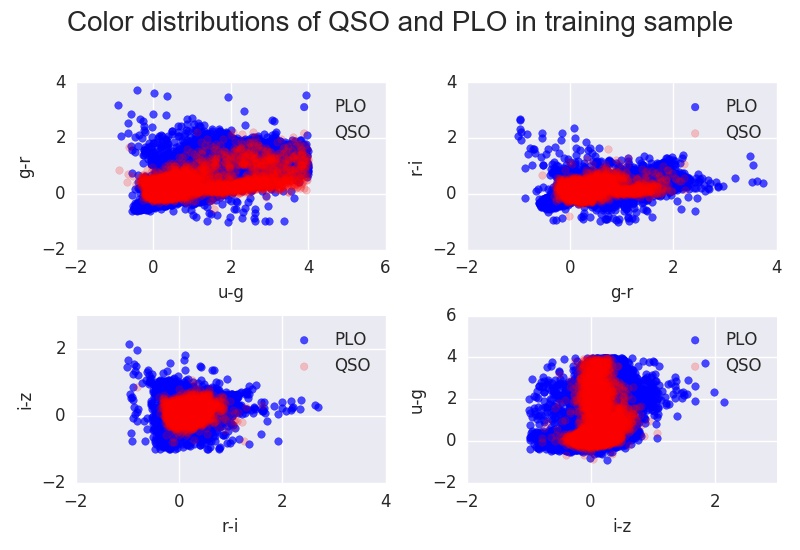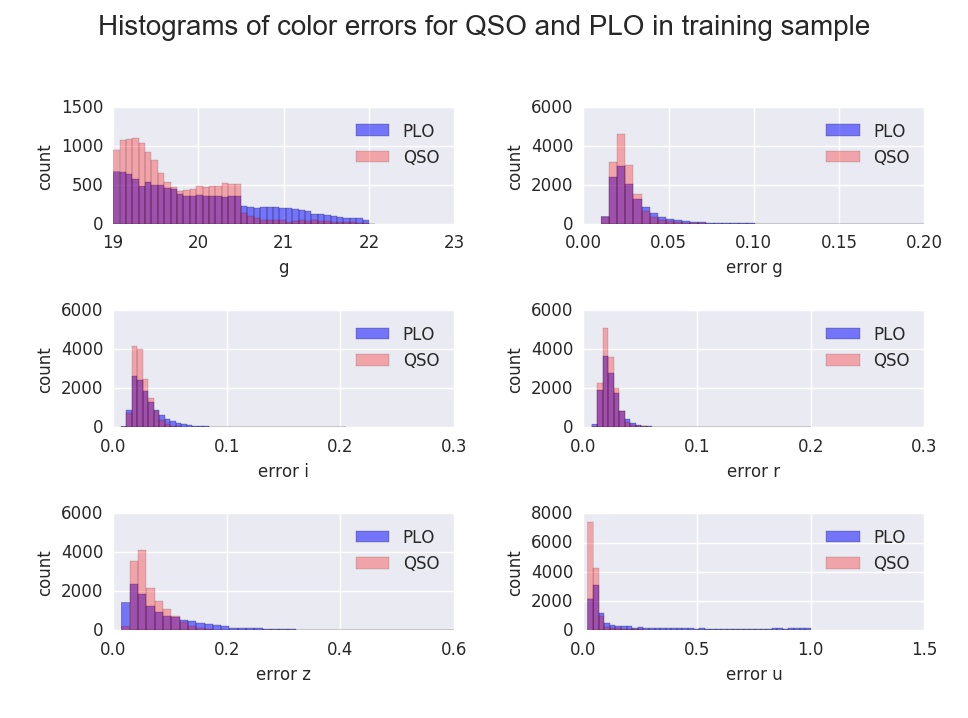Data
This page describes the publicly available data set which can be queried here SDSS DR7 DATA


- We choose 30000 known QSO (quasars) and their properties using the SQL commands
SELECT TOP 30000 s.z,s.zErr, s.specClass, p.psfMag_u, p.psfMag_g, p.psfMag_r, p.psfMag_i, p.psfMag_z, p.psfMagErr_u, p.psfMagErr_g, p.psfMagErr_r,p.psfMagErr_i,p.psfMagErr_z FROM BESTDR7 as s
JOIN BESTDR7 AS p ON s.bestObjID = p.objID
WHERE (s.specClass = dbo.fSpecClass('QSO') OR s.specClass = dbo.fSpecClass('HIZ_QSO')) AND s.zConf>0.35 AND s.z>0.5 AND s.z<5 AND p.psfMag_u>0 AND p.psfMag_u<26 AND p.psfMag_g>19 AND p.psfMag_g<25 AND p.psfMag_r>0 AND p.psfMag_r<24 AND p.psfMag_i>0 AND p.psfMag_i<24 AND p.psfMag_z>0 AND p.psfMag_z<24 AND p.psfMagErr_u>0 AND p.psfMagErr_g>0 AND p.psfMagErr_r>0 AND p.psfMagErr_i>0 AND p.psfMagErr_z>0
- We choose 30000 other point-like objects (PLO) using the following commands
SELECT TOP 30000 s.z,s.zErr, s.specClass, p.psfMag_u,p.psfMag_g,p.psfMag_r,p.psfMag_i,p.psfMag_z, p.psfMagErr_u,p.psfMagErr_g,p.psfMagErr_r,p.psfMagErr_i,p.psfMagErr_z FROM BESTDR7 as s
JOIN BESTDR7 AS p ON s.bestObjID = p.objID
WHERE (s.specClass = dbo.fSpecClass('STAR')) AND p.psfMag_u>0 AND p.psfMag_u<26 AND p.psfMag_g>19 AND p.psfMag_g<25 AND p.psfMag_r>0 AND p.psfMag_r<24 AND p.psfMag_i>0 AND p.psfMag_i<24 AND p.psfMag_z>0 AND p.psfMag_z<24 AND p.psfMagErr_u>0 AND p.psfMagErr_g>0 AND p.psfMagErr_r>0 AND p.psfMagErr_i>0 AND p.psfMagErr_z>0
The samples have the same data cuts in their photometric properties.
-
The samples are labelled 1 for QSO and 0 for PLO and are combined, shuffled and split into a training-set, cross-validation set and a test-set with 0.5, 0.25 and 0.25 of the data respectively.
-
In astronomy we define the colours of an object to be the difference in the values between two bands for example psfMag_u - psfMag_g above is the u-g band. The u-g, g-r, r-i, i-z colours are added to the data.
-
In the neural network we initially use 10 input parameters (following https://arxiv.org/abs/0910.3770 ). They are the 4 colours defined above, the g magnitude and the 5 magnitude errors i.e. psfMagErr_z etc.
Training set input parameter distribution
The 10 input parameters of each object are shown in the two plots at the top of the page. The QSOs are in red and the PLOs in blue. The objects cannot be classified by applying simple cuts to any of these attributes.